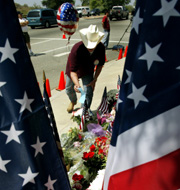June:Flag Day(美国国旗日)
(单词翻译:单击)
| Flag Day (US) |
| June 14 |

National flags are not merely symbols of a country. Their colors and designs convey past history and future goals. Flags have powerfulconnotations(内涵). They speak to the people and politicians. People of one country will burn the flag of another with whose politics they do not agree. To show their anger, students display their own nation's flags with the design altered or cut out completely. Dictators fly flags;dissidents(持不同政见者) rip them down. In every country of the world, the treatment of a flag displays an opinion or statement. Americans take the treatment of their flag seriously and in the 20th century this has become an important issue. Included in the code of ethics1 are such rules as the national flag cannot be used for advertising2. It cannot cover a monument or any ceilings. It must not be folded while being displayed. No one should write on an American flag. Ships can lower their flags slightly in greeting each other, but otherwise should not be dipped for any other object or person. In the late 1960s, American students wore small flags sewn to the back of their jeans, symbolically3 insulting the American government and protesting its involvement in the Vietnam War. They burned the American flag in front of theCapitol Building(国会大厦)in Washington as a statement of protest. In the early 1990s, senators suggested an amendment4 to theConstitution(宪法)that would make this treatment of the flag illegal. Theproposition(提议、议案)was opposed because many others felt that this change would be a violation5 of Americans' constitutional rights to express their opinions freely. For all the controversy6 it is interesting to point out that the United States did not even have a standardized7 flag until 1912! Called the "Stars and Stripes," or "Old Glory," the flag is one of the most complicated in the world. No other flag needs 64 pieces of fabric8 to make. The current flag has 13 red and whitealternating(交互的)stripes (representing the original 13 states) and 50 stars (each star represents one of the states of the Union) on a blue background. The American flag has also changed designs more than any other flag in the world. The first flag, called the Grand Union, was first flown at the headquarters of the Continent Army on January 1, 1776. Betsy Ross, aseamstress(女裁缝), is said to have contributed to this design. She had anupholstery(室内装潢)business which made flags for navy ships in Pennsylvania. A legend still persists that she showed George Washington how to make a five-pointed star and suggested thirteen stars in a circle for the first flag. Her descendants claimed that she offered the design. Actually, she and George Washington never met! George Washington did design the Grand Union. On June 14, 1777, the Continental9 Congress proposed that the United States have a national flag instead of the British Union Jack10. The 13 stars of the flag represented the 13 new states. There were few public ceremonies honoring the Stars and Stripes until 1877, when on, June 14, it was flown from every government building in honor of thecentennial(百年纪念)of the adoption11 of a national flag. Schools hadunfurled(展示)American flags over their doors or outside the buildings long before this; but in 1890, North Dakota and New Jersey12 made a law that required their schools to fly the flag daily. The first official Flag Day was observed in Philadelphia, Pennsylvania in 1893. New York also proclaimed June 14 as Flag Day 1897. Other states were slow to follow. Some people thought that the day was too close to Memorial Day and Independence Day. In August 1949, President Harry13 S. Truman proclaimed June 14 as Flag Day. Since then the President proclaims thecommemoration(纪念会)yearly, and encourages all Americans in the country to display the Stars and Stripes outside their homes and businesses. Individual states determine how they will observe the day. In Pennsylvania and American Samoa it is a public holiday. Usually the flag is flown from all public buildings, speeches are made in public places and ceremonies take place in towns or cities |
 收听单词发音
收听单词发音
1
ethics

|
|
| n.伦理学;伦理观,道德标准 | |
参考例句: |
|
|
|
2
advertising

|
|
| n.广告业;广告活动 a.广告的;广告业务的 | |
参考例句: |
|
|
|
3
symbolically

|
|
| ad.象征地,象征性地 | |
参考例句: |
|
|
|
4
amendment

|
|
| n.改正,修正,改善,修正案 | |
参考例句: |
|
|
|
5
violation

|
|
| n.违反(行为),违背(行为),侵犯 | |
参考例句: |
|
|
|
6
controversy

|
|
| n.争论,辩论,争吵 | |
参考例句: |
|
|
|
7
standardized

|
|
| adj.标准化的 | |
参考例句: |
|
|
|
8
fabric

|
|
| n.织物,织品,布;构造,结构,组织 | |
参考例句: |
|
|
|
9
continental

|
|
| adj.大陆的,大陆性的,欧洲大陆的 | |
参考例句: |
|
|
|
10
jack

|
|
| n.插座,千斤顶,男人;v.抬起,提醒,扛举;n.(Jake)杰克 | |
参考例句: |
|
|
|
11
adoption

|
|
| n.采用,采纳,通过;收养 | |
参考例句: |
|
|
|
12
jersey

|
|
| n.运动衫 | |
参考例句: |
|
|
|
13
harry

|
|
| vt.掠夺,蹂躏,使苦恼 | |
参考例句: |
|
|
|




